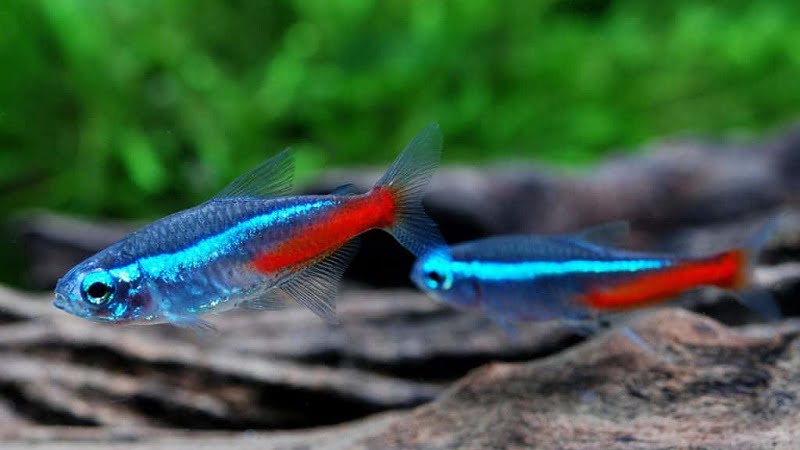The true neon tetra is very popular among aquarium hobbyists owing to its attractive coloration. Characterized by the distinctive blue, red, and silver-white color on the bodies, the true neon tetra can add more liveliness to your home community tank.
Like the other fish species, besides the original appearance of the true wild-form neon tetra, there are other fascinating neon tetra fish types with different appealing body colors and patterns, mostly thanks to selective breeding.
This article will discover 9 neon tetra fish types, which provides you with more options when deciding to introduce neon tetras to your tank.
True Wild-form Neon Tetra Fish Types
A long history of aquarium hobbyists has been devoted to the Neon Tetra, also called Paracheirodon innesi or Hyphessobrycon innesi (scientific names). With a head and back in light blue, these bright Neon Tetras will probably add vibrancy to any peaceful community aquarium.
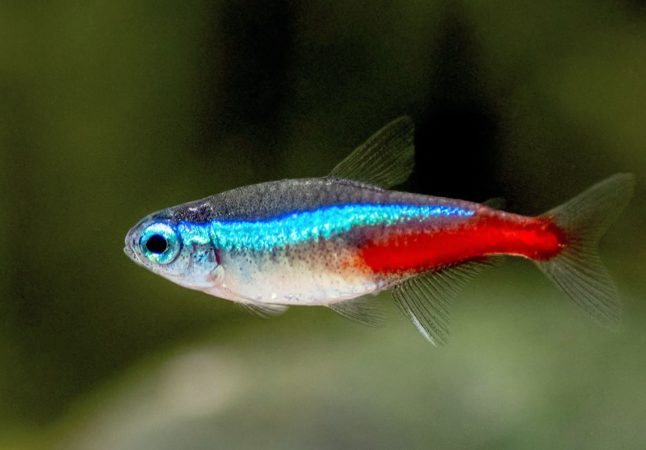
On both sides of their bodies, they have an iridescent, blue stripe running from their nose to their adipose fin, along with a red stripe running from their anal fin to their tail.
They also have shiny silver abdomens. Besides, their fins are mostly transparent, which means the color on their body does not spread to their fins’ area.
True Neon Tetras are one of the most recognizable and favorite fish species. As a result, they have been selectively bred to produce a variety of fascinating and unique variants, such as albinos, ‘golden’ (leucisms), longfin, and ‘diamond’ (reflective scales on the dorsal surface of the fish).
Neon tetras can also change the intensity of their overall color pattern in bright conditions with pale substrates or backgrounds and clear water and will become duller at night with a violet lateral stripe as a response designed to make them less easily visible.
4 Variants Of True Neon Tetra Fish Types
Longfin Neon Tetra (Paracheirodon innesi)
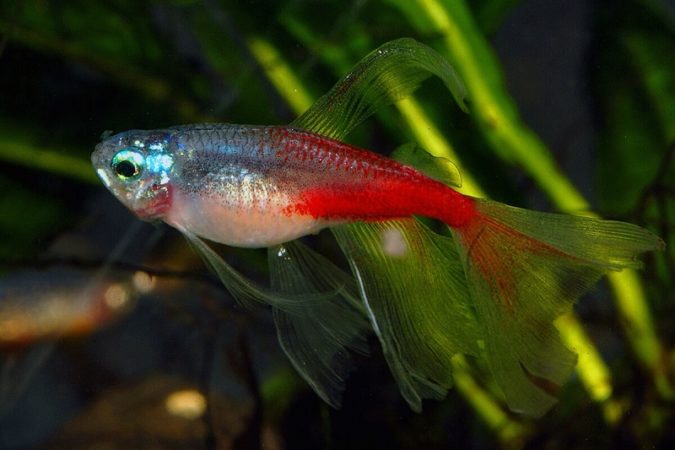
The captive-bred longfin neon tetras look very similar to their wild-form neon tetra types, but their colors are subdued and their fins are considerably longer. Specifically, their fins are twice as long as those of true neon tetras.
So, the longfin neon tetras share a similar lifespan, suitable habitat, and physical characteristics to true neon tetras. Yet, they might have difficulty schooling naturally since their fins could be easily nipped by other fish mates when schooled with each other.
Diamond Head Neon Tetra (Paracheirodon innesi var. diamant)
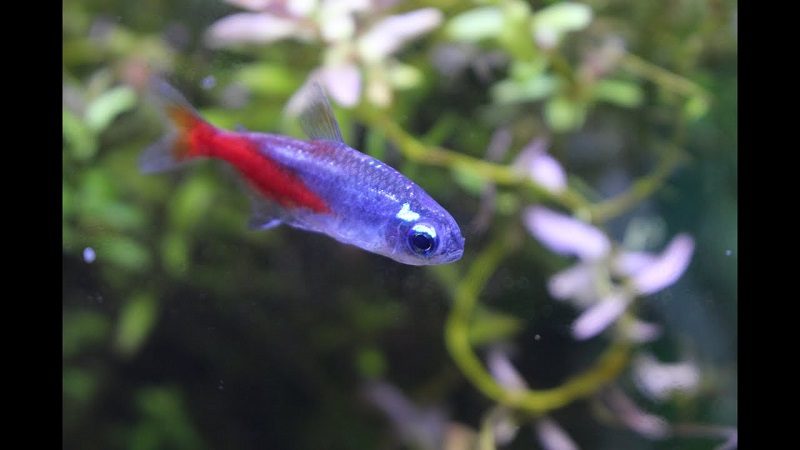
Diamond Head Neon Tetras originate in South American clear waters. They are a variant of true neon tetra types (Paracheirodon innesi), and have been developed through selective breeding.
A Diamond Head Tetra will have reflective scales, which is similar to the diamond shape, on its dorsal surface and on its back between the eyes. These diamond neon tetras are characterized by horizontal blue stripes offset by red along the side of their bodies.
They aren’t very big, and they are also pretty peaceful, so they can easily be housed in a peaceful community tank. As these fish are top-level and middle-level dwellers, taller plants would be most appropriate in their aquarium. Besides, to avoid them getting bullied by other fish mates, keeping them in a group of 6 or more is recommended.
These diamond variants of neon tetra eat frozen bloodworms, shrimp, flakes of high-quality food, and micro pellets. The pH of the water should range from 4-8, and the temperatures should fall between 20-26°C, with a minimum 10-gallon tank size for them to thrive healthily.
Albino Neon Tetra
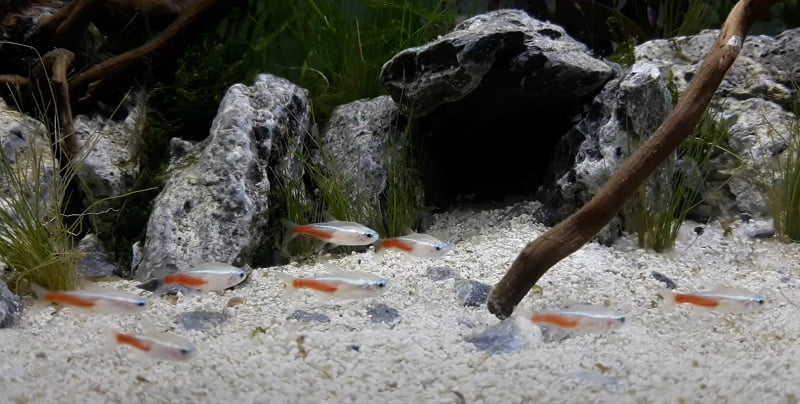
Albino Neon Tetras have been selectively bred in captivity to possess their coloration and not live in the wild with other Neon Tetras. To breed more Albino Neon Tetras, the breeder selected a female and a male of their albino neon tetras to spawn and produce offspring.
Their bodies have a pearlescent hue as opposed to a bright, vibrant blue stripe on the wild neon tetra types. They are still striped with red but lack the blue iridescent markings of true neon tetras. In addition, their eyes are red or pink due to a lack of coloration genes.
In terms of caring and living environments, albino neon tetras must be treated the same as any other neon tetra.
Brilliant White Neon Tetra (color variant of P.innesi)
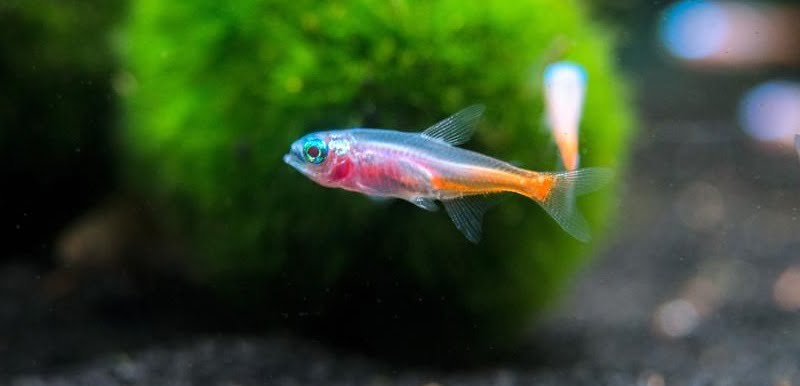
This brilliant white variant of neon tetra types is a rare and new variation to the wild-form neon tetra. It is sometimes called albino neon tetra, though these fish are not strictly albino. Particularly, the brilliant white neon tetras lack the dark gray coloring on their main body, and the other colors also appear to be faded.
Normally, brilliant white neon tetra resides at the top and middle levels of the water column, but they can also be seen swimming and feeding at the bottom and middle levels of the water column. These fish are not aggressive so they are safe tank mates to several peaceful fish. Like other neon tetra types, they need to be housed in a school of at least 6 individuals. As a tank-raised species, brilliant white neon tetra is extremely adaptable, however, its natural environment consists of soft, acidic, tannin-rich waters.
A diet rich in meaty foods will keep the Brilliant White Neon Tetra very colorful and thriving. All food types will be readily accepted, including high-quality flakes, pellets, and frozen or freeze-dried meats.
Gold Neon Tetra (color variant of P.innesi)
Gold neon tetras are a uniquely colored variation of neon tetras introduced through selective breeding. Their gold and opal coloration contrasts beautifully with the green and red plants found in many planted aquariums.
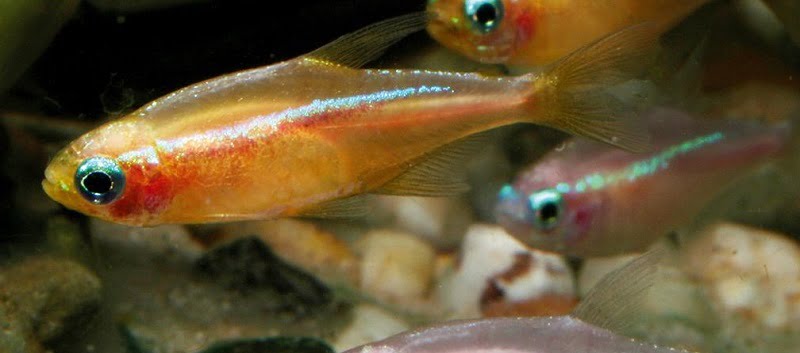
In fact, gold neon tetras have a red and silver color combination on their bodies. They have blue eyes, owing to leucism. Their bodies are silvery-peach and translucent, with a red-gold line running from their snouts to their tails. Their dorsal fin edges are red, while their anal and pelvic fin edges are white.
The gold neon tetra is a peaceful and easy to care for species. Other neon tetras and cory catfish, as well as barbs and danios, can be good companions. They prefer schooling in a group of 6 or more.
The pH level of the water must be between 5.8 and 7.5, and the tank should be at least 15 gallons to make them happy. Their preferred water temperature is 24-28°C, like that of other neon tetras. Gold neon tetras do not feed on food at the bottom; they consume frozen foods, flakes, and live food as well. It is recommended that they are fed with small amounts of food but frequently.
Related Species In The Same Family Of The Neon Tetra
Red Neon Tetra (Cardinal Tetra) (Paracheirodon axelrodi)
Red Neon Tetra is the common name of Cardinal tetra which is also known as Paracheirodon axelrodi for the scientific name. The cardinal tetra is in the same genus and close relative with the true neon tetra – Paracheirodon innesi.
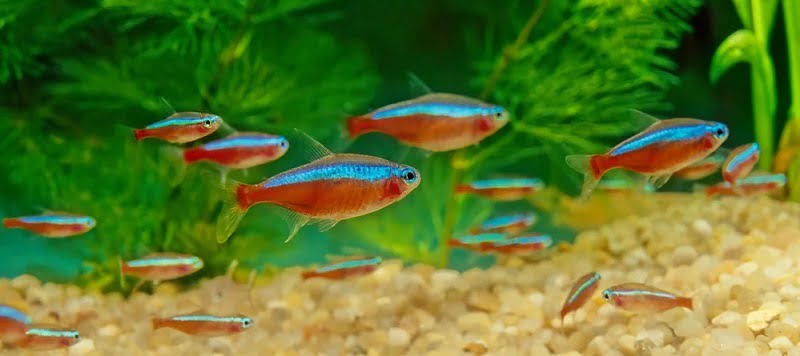
In particular, the cardinal tetra can be distinguished from the true neon tetra by its brighter, and more gaudy with full-body red coloring rather than just the back. The cardinal tetra is also more delicate and requires a little more care. The Neon Tetra is every bit as attractive as the Cardinal fish, but it is much easier to keep, and it can be bred easily too.
Red neon tetras are small fish with social behavior and peaceful temperament, making them easily get along with other similar small fish. This species can live in a tank with danios, rasboras, and a variety of other small neon fish. Their main habitat is in the middle of the water column.
Red neon tetras thrive in a minimum 10-gallon tank with moderate lighting, adequate swimming space, and well-planted aquariums. Additionally, water temperatures between 23 and 27°C and a pH level below or equal to 6 are ideal for red neon tetras. Last but not least, you should also refrain from changing the water’s chemistry frequently.
Green Neon Tetra (Paracheirodon simulans)
Green neon tetras are in the same genus as neon tetras and cardinal tetras. Because they are often confused with their relatives, they are often called blue neon tetra or false neon tetra.
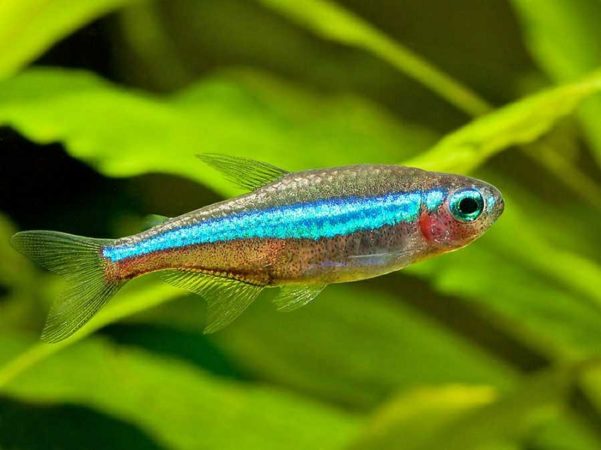
However, the vividness of the coloration on green neon tetras is different from the other two neon relatives. The lower part of their body, in particular, has a fainter red color (horizontally; similar to neon tetras) and the upper part has an interesting greenish-blue color. In addition, their heads and backs tend to be green in color, while their neon strips tend to be more prominent. If they are housed together with other neon tetra types, their differences become much more apparent.
These green neon tetras have a shorter lifespan than their related species, just around 2 – 3 years. Despite their peaceful nature, they are too small to thrive well in a community. Ideally, they should be kept in a group of at least 8 individuals of the same type.
They are omnivores and they usually feed on live foods such as tiny insects, mosquito larvae, and crustaceans. Their living temperature ranges from 24°C to 35°C with an appropriate pH level of about 3 to 6.5.
Black Neon Tetra (Hyphessobrycon herbertaxelrodi)
Black Neon Tetra is in a different genus from the true neon tetra, but they do similar to the popular neon tetra types.
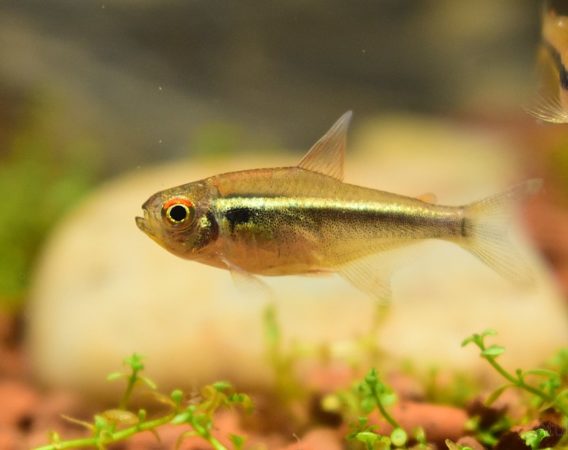
They have darker coloration and big eyes that are surrounded by an orange semicircle. On their body, a fine horizontal line extends from the gill cover to the caudal fin. Their entire body is greyish brown; and they have one black and one bluish-white lines, as well as some yellowish and greenish shimmering marks.
Black neon tetras are favored because they are hardy fish, which makes them highly adaptable to changes in water parameters, and require low-maintenance, as well as easy care. it can adapt to a lot of changes in water parameters. The black neon tetra should be kept with a group of at least six neon tetras like other tetras. This social tetra species swims at the top of the water column, so peaceful inhabitants at the middle or bottom of the water column make suitable tank mates.
The average lifespan of a Black Neon Tetra is five years. They require at least a 20-gallon tank with an ideal temperature and pH level between 24-28°C and less than 7.5. They can be fed flake or pellet food, but freeze-dried bloodworms and brine shrimp are better.
Video: Neon Tetras vs Cardinal Tetras
FAQs
Can I mix neon tetras and cardinal tetras?
It’s fine to keep these tiny, peaceful tetras together, like neon tetra, cardinal tetra, and glowlight tetra. These species do well together.
Do neon tetras need live plants?
In a neon tetra tank, live plants are not absolutely essential. However, keeping live aquarium plants in the tank has many benefits. Neon tetras in particular will feel more secure and relaxed in live aquarium plants, which provide them with hiding places.
Can you mix different neon tetras?
The answer is yes. As long as there are enough members of their own species, different types of tetra can school together. Also, the aquarium should be set up properly to accommodate tetras.
Conclusion
These peaceful little neon tetras are vibrant, enchanting, and peaceful to watch. Different neon tetra types will come with different colorations, thus you can have various options to build a lively community tank with your favorite neon tetras. Hopefully, after reading this article, you can choose your most favorite and suitable neon tetra types for your home aquarium.
References:
- https://en.wikipedia.org/wiki/Paracheirodon
- https://www.seriouslyfish.com/species/paracheirodon-innesi/
- https://www.seriouslyfish.com/species/paracheirodon-axelrodi/
- https://www.seriouslyfish.com/species/paracheirodon-simulans/

Annette M. Chaney is an experienced marine biologist with over 20 years of experience as an aquarist and fishkeeper. She started her first aquarium at a young age, filling it with frogs and goldfish obtained from the ten-cent pet store.
Annette grew up caring for and breeding African Cichlids, which led to a hobby in high school that doubled as a profitable means. Attending Reed College gave her time to solidify herself as an accomplished aquarium caretaker with an eye for sales. After that, from 2009 – 2013, she studied at Roger Williams University – one of the most prestigious universities for Aquaculture and Aquarium in USA. She is the founder of AquariumCircle since 2010.
